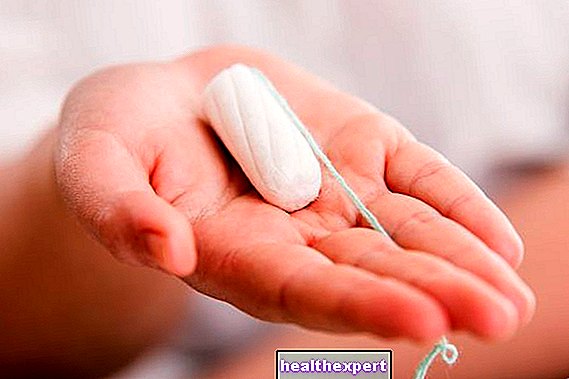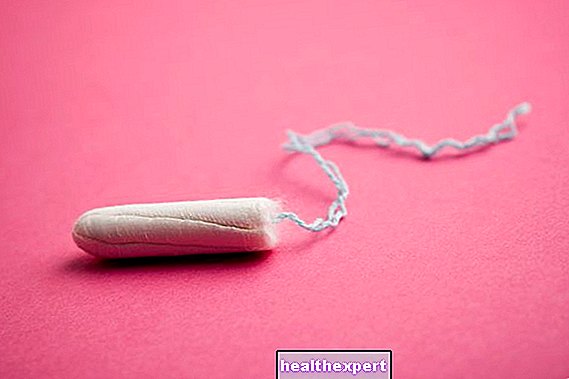Internal sanitary napkins: how to put them on? They hurt? Risks, contraindications and everything you need to know
Internal pads, also known as tampons, have the ability to absorb menstrual blood directly from the inside of the vaginal canal. Unlike the external ones, the blood does not come out of the vagina at all, and this is a great advantage, above all. from a hygienic point of view.
Despite these premises, however, external sanitary pads continue to be more common and there is a certain diffidence towards tampons: are they bad for you? What are the risks involved in using them? Can they also be used as a virgin? How do they fit?
Read on and we will try to put an end to these doubts and also to those concerning contraindications and risks, for a more conscious use of tampons and without prejudice. In front of a tampax, don't you want to react like these kids?
The characteristics of tampons
How are tampons made? Inside them, if they are of good quality, they contain pure and hydrophilic cotton, with high absorbency. In other cases, however, together with cotton you can find materials such as rayon, a derivative of cellulose.
A small cable is tied to the pad that will remain outside the vagina: it will in fact be used to pull the tampon out when changing it. Some pads, then, are equipped with an applicator, a double tube (external and internal) in plastic that retracts after having it inserted and making it easier to insert it into the vagina.
In the packaging in which it is sold, the tampon is lined with a plastic wrap (a bit like the outside) in order to keep it sterile and clean.
There are also different types of tampons that vary their size according to the menstrual flow, whether abundant or not, or to the different cycle, it is advisable to buy one with high absorbency, which therefore has at least three drops drawn on the package.



Internal tampons type tampax or type o.b.?
As previously mentioned, tampons can be provided or not with an applicator and this is the main difference between the Tampax type and that of the o.b., to name the most well-known brands.
Apparently they don't look that different, but Tampaxes come with a special applicator and expand in length as they absorb menstrual blood. Obs, on the other hand, do not have an applicator and expand radially. their diameter to increase, instead of length.
It's up to you to try them out to find out which is the most comfortable for you!

Internal sanitary napkins: how to put them on?
How do you put on a tampon? Many women are convinced that it is a "complicated" operation, but in reality it is simpler than expected and simply requires a minimum of practice. quite natural how to use tampons!
The first thing to do to learn how to put them on is: relax. If the body, and in particular the pelvic muscles, are stiff, you will find it much more difficult to put it on. Find a comfortable position and take your time, at least the first few times. Generally it is recommended to put it on sitting on the toilet, but you can do it even standing up: just bend your legs slightly to facilitate insertion.
Also remember that hygiene is very important: wash your hands before inserting it!
How do you put the tampax type and how the o.b.?
The tampons such as Tampax must be inserted by means of the applicator which, as we said, is a double external / internal tube: the absorbent is inside it. Then place the applicator at the entrance of the vagina, with the cord which hangs downwards. Insert the applicator into the opening until the fingers pushing it touch the vagina in turn. Then, with your index finger, push the inner tube into the outer one: the sanitary pad will be in its placed in automatic mode. Then remove the applicator.
The tampons of the type o.b., on the other hand, having no applicator must be pushed directly into the vagina. After opening one, untie the cord and remember, also in this case, to hang it outside. Bring the tampon close to the vaginal opening with your fingers, helping with your free hand to open your lips as much as possible. "absorbent in the vaginal cavity upwards: it will be in place when you no longer notice you have it.

How do you remove (or change) a tampon?
The tampon should be changed on average every 4-6 hours, when it is completely soaked in blood, and in any case it should not be kept for more than 8 hours in a row.
To remove it, just use the special hanging cord on the outside. Assume the same position in which you put it on to facilitate the operation, again relax the pelvic muscles and pull the cord.
At that point, wrap it in toilet paper or in the wrapping of what you are going to replace it with and throw it in the trash, avoiding the toilet so as not to clog it.
The advantages of tampons
Are you wondering why you should prefer an internal tampon to an external one? The most obvious reason is given to you by the summer, in which having your period is never pleasant ... if you are lucky enough to spend your holidays by the sea (but the same goes for the swimming pool and in any season of the year! ), using a tampon will allow you to bathe safely.
The tampon, then, compared to the outside allows you to move at ease and with great comfort, without being afraid of leaks. Also, if you were wondering, you don't need to take it off if you have to go to the bathroom.
The material that composes them is safe, it does not alter the pH of the vagina or modify the local bacterial flora. Plus, we assure you, once you get the hang of it it's super-easy to insert!

Risks and contraindications of tampons
Com "it is obvious, however, even tampons have their contraindications and their risks, first of all forget to change it: it should not be kept more than 8 hours in the vagina or it can cause serious irritation!
The tampons should be avoided if you suffer from vaginal infections or have particular anatomical alterations in the genital area: always ask your gynecologist for advice in case.
An additional risk may be given by some particular form of hypersensitivity to the components of the pad. In that case, you can try menstrual cups.
In any case, they should not be used as a precaution if you do not already have your period, or for vaginal discharge.
Apart from these precautions, using tampons has no particular contraindications, nor (unfortunately) does it have the slightest influence on menstrual problems, from headaches to menstrual delays ...
Internal tampons and virginity: can they also be used as a virgin?
This question is very often asked by girls who have not yet lost their virginity: can the tampon be used anyway or does it lead to rupture of the hymen by inserting it into the vagina? The answer is: absolutely yes!
The insertion of a tampon does not involve the rupture of the hymen which will remain intact until your first sexual intercourse. The sanitary pad, in fact, is inserted into the same cavity from which the flow of menstrual blood comes out.

Do tampons hurt?
Here is another "question that women ask themselves most frequently: do tampons cause pain? Does it hurt to insert them? Also in this case, doubts and fears can be dispelled: inserting them does not cause pain.
Of course, this is a very personal matter and, as mentioned above, the first time may not be so simple: anxiety leads us to stiffen the vaginal muscles and, as happens for penetration during sexual intercourse, it can create If, however, we can relax and insert the tampon correctly, we will not feel any pain, on the contrary ... we will not even notice that we have it!
If pain is felt during insertion, it is likely that the reason is a contraction of the levator ani muscle which leads to incorrect positioning of the tampon.
The best choice, in any case, is to contact your gynecologist for any doubts, advice or problems, who will be able to give you precise and personalized instructions on every aspect of the use of tampons.
For more useful information on tampons, you can visit the Humanitas website.
Meanwhile, to pamper yourself from the pains of your period and recover from the fatigue it entails, pamper yourself with some of these foods against fatigue: